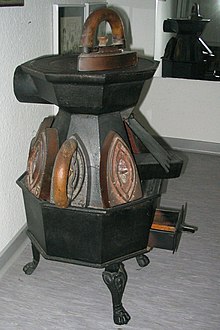Ironing

Ironing is the use of an
The first known use of heated metal to "iron" clothes is known to have occurred in China.[4] The electric iron was invented in 1882, by Henry Seely White. Seely patented his "electric flatiron" on June 6, 1882 (U.S. Patent no. 259,054).[5]
Equipment
Iron
The iron is the small appliance used to remove wrinkles from fabric. It is also known as a clothes iron, steam iron, flat iron, smoothing iron or iron box.
On 15 February 1858 W. Vandenburg and J. Harvey patented an ironing table that facilitated pressing sleeves and pant legs.[6] A truly portable folding ironing board was first patented in Canada in 1875 by John B. Porter. The invention also included a removable press board used for sleeves.[7] In 1892 Sarah Boone obtained a patent in the United States for improvements to the ironing board, allowing for better quality ironing for shirt sleeves.[8]
Ironing board cover sizes
| Size[citation needed] | Inches | Centimeters |
|---|---|---|
| A | 43 × 12 | 110 × 30 |
| B | 49 × 15 | 124 × 38 |
| C | 49 × 18 | 124 × 45 |
| D | 53 × 18 | 135 × 45 |
| E | 53 × 19 | 135 × 49 |
Tailor's ham
A tailor's ham or dressmakers ham is a tightly stuffed pillow in the shape of a ham used as a mold when pressing curves such as sleeves or collars.[9]
Commercial equipment
This section possibly contains original research. (September 2017) |
Commercial dry cleaning and full-service laundry providers usually use a large appliance called a steam press to do most of the work of ironing clothes. Alternatively, a rotary iron may be used.

Historically, larger tailors' shops included a tailor's stove, used to quickly and efficiently heat multiple irons. In many developing countries a cluster of solid irons, heated alternatively from a single heating source, are used for pressing clothes at small commercial outlets.
Automation
Different machines promise to automate ironing, such as Effie and Panasonic Sustainable Maintainer. Both machines individually treat clothes and then fold them onto a shelf.[citation needed]
Recommended ironing temperatures

| Textile | Temperature[citation needed] | Temperature[2] | Dot mark |
|---|---|---|---|
| Toile | 240 °C | ||
Triacetate ("Estron", "Silene", "Tricell") |
200 °C | 220–250 °C | |
| Cotton | 204 °C / 400 °F | 180–220 °C | * * * [10] |
| Linen (flax) | 230 °C / 445 °F | 215–240 °C | * * * [10] |
Viscose /Rayon |
190 °C | 150–180 °C | * * [10] |
| Wool | 148 °C / 300 °F | 160–170 °C | * * [11] |
| Polyester | 148 °C / 300 °F | * [10] | |
| Silk | 148 °C / 300 °F | 140–165 °C | * [11] |
SympaTex |
* [10] | ||
| Acetate ("Arnel", "Celco", "Dicel") | 143 °C | 180 °C | * [11] |
| Acrylic | 135 °C | 180 °C | |
| Lycra/spandex | 135 °C | ||
| Nylon-6 | 150 °C | 150 °C | * |
| Nylon-66 | 170 °C | 180–220 °C | *** |
| Dot mark | Temperature |
|---|---|
| * | < 110 °C |
| * * | < 150 °C |
| * * * | < 200 °C |
Another source suggests slightly higher temperatures, for example, 180-220 °C for cotton[2]
Chemistry
This section possibly contains original research. (September 2017) |
When the fabric is heated, the molecules are more easily reoriented. In the case of cotton fibres, which are derivatives of
See also
- Domestic robot
- Hair iron
- Laundry symbol
- Mangle (machine)
- Ironing mannequin
- Self-service laundry
- Washing machine
References
- ^ "Ironing". The Free Dictionary By Farlex. Retrieved 2012-05-24.
- ^
- ^ "IRONING definition". linguazza.com. Retrieved 2022-07-12.
- ^ Oldandinteresting.com
- ^ Enchantedlearning.com
- ^ U.S. patent 19,390
- ^ Mario Theriault, Great Maritime Inventions 1833–1950, Goose Lane, 2001, p. 31
- ^ Ramirez, Ainissa (July 26, 2020). "Two inventors who should have statues". The Hartford Courant. Retrieved 6 August 2020.
- ^ "Tailor's ham and Seam Roll Free Pattern". Sewing Princess. Retrieved 2012-05-24.
- ^ a b c d e "Bra att veta vad man har på sig" (PDF). Ulla Popken. Archived from the original (PDF) on 2009-11-22. Retrieved 2010-02-04.
- ^ a b c "General care" (PDF). Lanidor. Archived from the original (PDF) on 2011-07-13. Retrieved 2010-02-04.
External links
- History of Ironing from oldandinteresting.com
- Theory and Technology of Ironing
- Antique Irons from the Virtual Museum of Textile Arts
